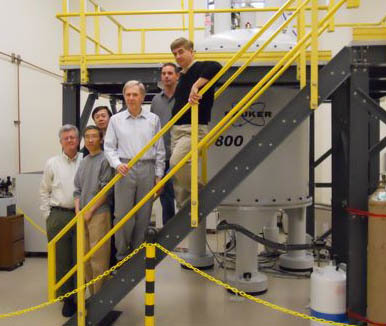
The Lizzadro Magnetic Resonance Research Center operates seven different nuclear magnetic resonance (NMR) spectrometers to support research at the University of Notre Dame in chemistry, biochemistry, molecular biology and related fields. Shahriar Mobashery's research group would not have been able to accomplish such breakthrough work without this facility and the use of the 800 MHz instrument.
Chemical structure is directly relevant to the understanding of biological chemistry, as evidenced by the determination, using X-ray crystallography, that DNA has a double helical structure. Over the past decade, NMR spectroscopy has emerged as an alternative to X-ray crystallography for the determination of complex biological structure, and especially for biological structure that engages membranes. An outstanding example of the power of NMR spectroscopy to solve difficult biological structure is the determination of the structure of the ³anchor² peptide domain of a bacterial membrane protein, recently accomplished here by the Mobashery group.
The protein, which is the main focus of this study, is a target of the penicillin antibiotics. The structure of its anchor domain is important because this domain is used by an as yet undetermined mechanism to precisely localize the protein within the bacterium, and enable its correct participation in bacterial growth. From analysis of extensive two-dimensional NMR data, obtained on the high field NMR instrument of the Department of Chemistry & Biochemistry, the three-dimensional folded structure of this domain was solved. This is the first determination of such a structure, and thus provides the structural reference point for the future evaluation of the role the membrane environment has in modulating the anchor domain structure.
This study was reported in the Journal of the American Chemical Society (Vol. 132, Issue 12, p. 4110).
The NMR facility is crucial to research at Notre Dame. The instrument recently contributed to the success of Jeff Peng, associate professor of chemistry and biochemistry.
Photo Caption:
Authors pictured in the photo with the 800 MHz spectrometer from left to right are: Jed Fisher, Qicun Shi, Weilie Zhang, Jaroslav Zajicek, Peter O'Daniel and Shahriar Mobashery.